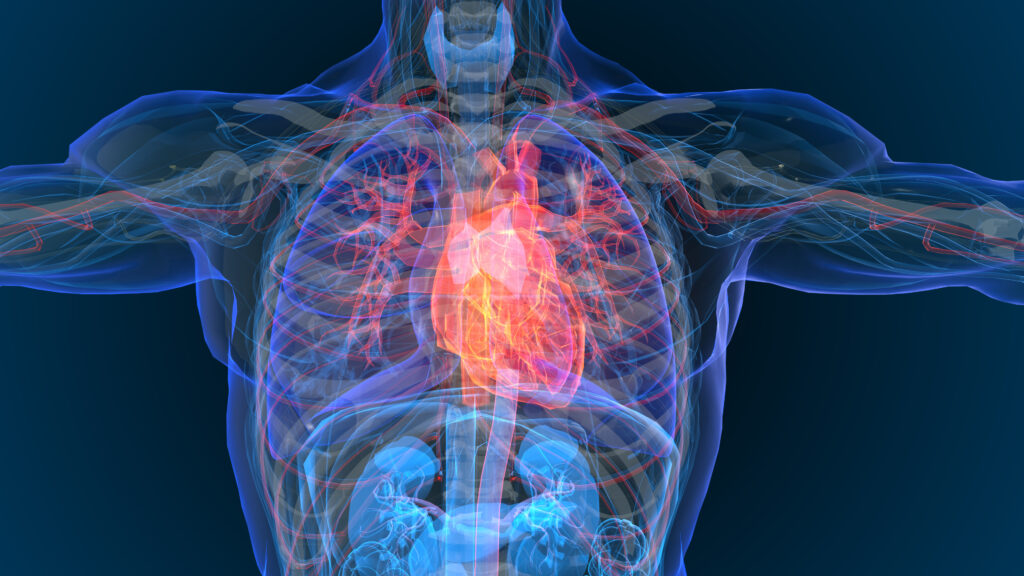Thyroid Hormone and its Receptors
The thyroid gland secretes two forms of thyroid hormone: T4 (3,3’,5,5’-tetraiodo-L-thyronine, thyroxine) and T3 (3,3’,5-triiodo-Lthyronine). While T4 has little biological activity and is considered a prohormone, T3 is the receptor-active form and exerts most of the thyroid hormone effects.1
Thyroid Hormone and its Receptors
The thyroid gland secretes two forms of thyroid hormone: T4 (3,3’,5,5’-tetraiodo-L-thyronine, thyroxine) and T3 (3,3’,5-triiodo-Lthyronine). While T4 has little biological activity and is considered a prohormone, T3 is the receptor-active form and exerts most of the thyroid hormone effects.1
Tissues can fine-tune their local T3 levels via deiodinases. These enzymes can, for example, activate T4 to T3 by removing an iodine from the outer ring of the hormone (deiodinase type I and II) or inactivate T3 to T2 by inner-ring deiodination (type I and III).2 Thus, the deiodinases allow certain tissues to regulate their T3 levels autonomously of circulating thyroid hormone.
For a long time it has been assumed that thyroid hormone passes cell membranes due to its hydrophobic properties by diffusion. This view has changed, however, with the recent discovery of specific thyroid hormone transporters, such as MCT8 (monocarboxylate transporter 8) or OATP1C1 (organic anion transport polypeptide 1c1).3 These transporters can modulate the response of tissues to thyroid hormone depending on their expression level. In the absence of MCT8, for instance, there is no significant uptake of T3 into the mouse brain.4
The third level of the cascade that determines the response of a tissue to thyroid hormone is represented by the two nuclear thyroid hormone receptors (TRα1 and TRβ). These receptors are encoded by two separate genes located on human chromosomes 17 (TRα1) and 3 (TRβ), or 11 and 14 in mice. The expression level of these two genes determines the responsiveness of the tissue to thyroid hormone. While TRβ is predominantly expressed in the liver and auditory system, TRα1 is the major isoform in skeletal muscle, brain and heart.1 It is still a matter of debate whether genes can be regulated specifically by a single isoform or whether the two receptors can compensate for each other when co-expressed in the same cell.5
Thyroid Hormone and the Heart
Thyroid hormone is well recognised for its profound effects on the cardiovascular system.6 In patients, hyperthyroidism often leads to tachycardia and cardiac arrhythmias, accompanied by vasorelaxation, decreased systemic vascular resistance, increased blood volume and systolic hypertension. Hypothyroidism on the other hand causes bradycardia, slowed relaxation and reduced cardiac output, together with vasoconstriction and diastolic hypertension.7,8 Despite these well-known symptoms of hyper- and hypothyroidism, the molecular mechanisms are incompletely understood. Moreover, other factors such as the age or metabolic condition of the patient strongly modulate the severity of the disorder.
To investigate the cardiovascular actions of thyroid hormone receptors, animal models devoid of one or both thyroid hormone receptors have been generated.9 Their analyses revealed that TRα1 represents more than 70% of thyroid hormone-binding capacity in the heart6 and is absolutely required for cardiac development.10 It is also involved in heart rate, relaxation time and the cardiac response to thyroid hormone.11 TRβ is also present in the heart, however, and contributes to the regulation of specific genes, such as cardiac myosin heavy chain.12 Together with the fact that a TRβ-selective agonist (GC-1) does not enhance cardiac output to the same extent as T3,13 it can be concluded that TRα1 exerts most of the physiological actions of thyroid hormone in the heart.
Aporeceptor Activity of Thyroid Hormone Receptors
Unlike steroid hormone receptors, thyroid hormone receptors also act in the absence of ligands as aporeceptors. These unliganded receptors (apo-TRs) can, for example, actively suppress the expression of thyroid hormone target genes; an activity that underlies the severe defects observed in untreated congenital hypothyroidism.1,14,15 The devastating effects of apo-TRs can be impressively demonstrated in the corresponding animal models. Mice born without a functional thyroid gland die within the first three weeks of life,16–18 while animals lacking all thyroid hormone receptors survive to adulthood.19 Although thyroid hormone signalling is disrupted in both models, the absence of the hormone is more devastating than the lack of receptors, because the latter also excludes aporeceptor activities.
Similar apo-TR effects can be observed at the molecular level. Hypothyroid mice show a severe repression in HCN2 (potassium/ sodium hyperpolarisation-activated cyclic nucleotide-gated channel 2), an important component of the cardiac pacemaker. On the other hand, animals lacking TRα1 display normal levels and only induction of the gene by T3 is abolished.20 Taken together, the results clearly demonstrate that unliganded thyroid hormone receptors can have drastic consequences that are not only noticeable at the level of gene regulation but also macroscopically, e.g. in postnatal survival.
These examples also show that mice lacking thyroid hormone receptor genes are not ideal models to analyse the effects of thyroid hormone due to the lack of aporeceptor activity. A second generation of animal models has therefore been developed: mice heterozygous for a point mutation in the ligand-binding domain of the thyroid hormone receptor. This reduces or abolishes affinity to T3 and locks the receptor in a constant aporeceptor state (‘receptor-mediated hypothyroidism’).
Consequences of an Unliganded Thyroid Hormone Receptor in the Heart
To analyse the consequences of apo-TRα1, several strains with a mutant thyroid hormone receptor were recently generated in different laboratories.21–25 This article will focus on the cardiovascular phenotype of mice with the TRα1R384C mutation (TRα1+/m mice), which has been analysed in detail in vivo and in vitro.25–27
As expected from a receptor-mediated hypothyroid state, the TRa1+/m mice displayed bradycardia. Furthermore, isolated cardiomyocytes of these animals showed a slower decay of intracellular calcium and consequently a prolonged relaxation time. The contraction of the isolated cells was not as pronounced or as fast as that of wildtype cardiomyocytes.25,27 At the molecular level, the expression of HCN2 was strongly reduced by the mutant TRα1.26 As even minor reductions in HCN2 can cause severe bradycardia,28 the observed reduction is likely to be the underlying molecular cause for the reduced heart rate in TRα1+/m animals.
Interestingly, although isolated TRα1+/m cardiomyocytes were more sensitive to β-adrenergic stimulation,27 the injection of the catecholamine isoprenaline did not raise the heart rate of TRα1+/m mice to an extent similar to that in wildtype animals.25 This suggests that an increased basal β-adrenergic stimulation might already exist in TRα1+/m animals, partially masking the intrinsic defects observed in isolated cardiomyocytes. Thus, the autonomic regulation of cardiac activity in these mutants was further investigated.
Consequences of a Mutant Thyroid Hormone Receptor For Autonomic Regulation
As the clinical symptoms of hyperthyroidism and excess catecholamine are quite similar, interactions between the two systems have frequently been discussed. The molecular mechanisms remain enigmatic and the observations in patients are contradictory. An increased activity of the sympathetic nervous system is observed in long-term hypothyroidism,29 but also in patients with untreated Graves’ hyperthyroidism.30,31 Catecholamine levels are usually normal if not lower in hyperthyroidism,32 however, suggesting that the interactions of thyroid hormone with catecholamine signalling might occur downstream of the receptor.
To identify the molecular mechanisms, different animal models have been analysed, but the results have not clarified the situation. Some observed a reduced catecholamine turnover in hypothyroid animals33 and an increased β-adrenergic responsiveness of cardiomyocytes in thyrotoxicosis.34 Others could not find any evidence for altered catecholamine response in dependence of the thyroid status.35 The results obtained from TRa1+/m mice have provided novel insights.
No difference was observed in the mRNA expression of β-adrenergic or muscarinic acetylcholine receptors in the heart between TRa1+/m mice and wildtype animals, indicating that the receptors themselves are most likely not subject to TRα1 regulation. Conscious and freely-moving TRα1+/m mice were injected with the cholinergic blocker scopolamine methyl bromide for parasympathetic denervation or with the non-selective β-adrenergic receptor blocker timolol for sympathetic denervation. In these animals, the changes in heart rate were similar to those observed in wildtypes. Thus, these analyses did not provide further evidence for a direct cross-talk between the mutant TRα1 with the autonomic regulation of heart rate.26
During night-time activity periods or when the mice were challenged with a mild stressor, however, adaptation of heart rate did not occur to the same extent in TRa1+/m mice as in wildtype animals. This effect was even more pronounced when the mice were reared at 30ºC, which reverses the autonomic control of heart rate in rodents from mainly sympathetic to parasympathetic control.36 While wildtype mice showed the switch in autonomic control at this temperature as expected, TRα1+/m mice continued to display a predominantly sympathetic regulation of cardiac activity.26 This suggests that mutant TRα1 impairs the autonomic adaptations of heart rate upon environmental changes.
In summary, the results obtained in mice with a mutant TRα1 indicate that the interactions of thyroid hormone and the autonomic regulation of heart rate can be minimal under baseline conditions. When challenged by anaesthesia, stress or changes in environmental temperature, however, the effects become more obvious. The findings thus underline the need to re-evaluate previous studies where the interactions of thyroid hormone and the autonomic control of heart rate might have been studied under non-baseline conditions, e.g. in anaesthetised animals.
Where are the Patients?
Mutations in TRβ that abolish or reduce thyroid hormone-binding to the receptor are well-known in humans and lead to thyroid hormone resistance syndrome, which was first described in 1967.37,38 The phenotype of these patients is characterised by reduced responsiveness of TRβ-expressing tissues and consequently elevated levels of thyroid hormone due to insufficient suppression of thyrotropin-stimulating hormone (TSH) in the pituitary. The high thyroid hormone levels in turn cause a hyperthyroid state in tissues expressing mainly TRα1, such as the heart and the brain.
Although the symptoms and penetrance are variable, the mixed hypo- and hyperthyroid phenotype is very characteristic. It is usually accompanied by goiter, tachycardia and occasionally with psychological disorders, such as learning disability or attention-deficit-hyperactivity disorder. Currently more than 300 patient families have been characterised with over 50 different mutations in TRβ, thus providing a good pool of clinical data that facilitate a reliable diagnosis.
Surprisingly, however, to date no patient has been identified carrying a mutation in TRα1. Several animal models have been generated to understand the consequences of a mutation in TRα1 and to predict a human phenotype.21–25 The task is complicated by the fact that a mutation in the TRα1 gene can – depending on location – not only lower T3 binding but also abolish interactions of the thyroid hormone receptor with specific co-factors, thus additionally modulating the phenotype. For instance, mice with the TRα1R384C mutation are metabolically lean, while a TRα1P398H mutation leads to obesity.22,25,39 This difference is probably caused by the different abilities of the two mutant receptors to interact with peroxisome proliferator-activated receptors.40 As the different mutants exhibited no gross abnormalities in thyroid hormone levels as adults, however, it is expected that TRα1 patients might also display inconspicuous thyroid hormone levels. This could explain why these patients have not been identified yet: the lack of a thyroid phenotype in the anamnesis would most likely lead to the conclusion that thyroid hormone signalling is not affected. The other common features of the different animal models with a mutant TRα1 have been used to predict a human phenotype.41,42
Childhood
Young patients with a mutation in TRa1 are likely to display lower birth weight and delayed physical and mental development. This could include growth retardation, young bone age, impaired speech development or disturbances in fine motor movement. Moreover, given the important role of TRα1 in the brain, a mutant TRα1 could contribute to symptoms such as panic disorder, autism, learning or memory problems, or even epilepsy.41,42 In terms of cardiovascular function, bradyarrhythmias as well as lower blood pressure might be observed. As TRα1+/m mutant mice display mild hypothyroidism as young animals, one could expect above-average TSH in the presence of normal T3 or T4 levels.
Adulthood
As adults, mental impairments such as anxiety, memory problems or seizures might be present. Given the cardiovascular phenotype of the TRα1+/m animals, a mild to severe bradycardia could be expected, accompanied by problems adapting the heart rate to environmental changes and stress. This could also include a higher sensitivity to β-blockers. Furthermore, metabolic abnormalities could occur: depending on the position of the mutation, either leanness with problems gaining weight or obesity with disturbed temperature sensation.
Given the fact that TRa1+/m mice benefit from treatment with thyroid hormone in several aspects, the identification of patients with a mutation in TRa1 seems an important goal. A close collaboration between scientists and clinicians will be required to identify and characterise the patients with a mutation in TRa1.
Conclusions
The transfer of cardiovascular knowledge from animal models to humans is complicated by the fact that the autonomic control of heart rate is mainly under sympathetic control in rodents at room temperature,43–45 while in humans parasympathetic regulation dominates. The analysis of mice with a mutant TRα1 has, however, provided new insight into the role of TRα1 in the cardiovascular system. Besides the expected intrinsic defects – such as reduced contractility, delayed relaxation and bradycardia – the animals also displayed an impaired autonomic adaptation on stress or alterations in environmental temperature. Although the molecular reason remains to be elucidated, these impairments most likely reside within the central circuits that control cardiovascular activity. Given the prominent role of TRα1 in the brain, these findings are not surprising.
Taken together, the TRα1+/m phenotype in mice indicates that thyroid hormone regulates cardiac activity mainly by direct effects on the heart, but also indirectly via the autonomic nervous system. The latter might not be obvious under baseline conditions, but can become relevant for the central adaptations of heart rate to external stimuli, such as stress. These findings should be kept in mind when designing experiments to investigate the interactions of thyroid hormone with the cardiovascular system, especially when they challenge autonomic control of heart rate, such as anaesthetics.













